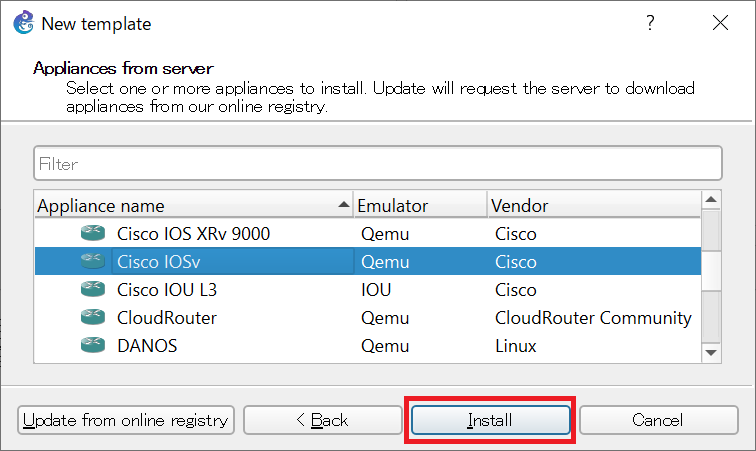Download Cisco IOS image for GNS3
- Cisco Ios Save Config
- Gns3 Iosv Startup Config.img
- Cisco Iosv 15.6
- Iosv Startup Config
- Cisco Startup Config

Hi dear all, that’s really a great to share my hard work with you , After a lots of hit in Google I finally found trick to search Cisco IOS in free of course. So without talking much here are the link where you can free download Cisco ios image and you can upload or use this ios to the router and as well as in GNS3.
Small Collection of IOS Images.
ftp://ftp.unikon-ua.net/pub/Cisco/IOS/
{Updated}Big Collection of IOS Images (Almost All Cisco IOS Images)
ftp://62.117.115.92/upload/ios/
Another Big Collection
(NEW)Cisco IOS Images Big Collection v3. **Direct HTTP Link**
http://www.jonsfiles.com/IOS%20Images%20for%20GNS3/Cisco_IOS_Collection/IOS/
Running GNS3-ER on a Windows 7 machine. I have the IOU's working successfully, but am unable to get an actual router to work properly. After loading the image (I'm using c3745-adventerprisek9-mz.124-25a.bin) in Preferences/IOS Routers/IOS Images, I am able to start up a 3745 router. But when I try to access it from the console this is all I get. Cisco helps you grow your business and your network reliably. Download Documentation Community Marketplace Training. Login Sign Up Sign Up. 9/15/ Hello guys, It is possible to extract IOSv (IOS ) from Cisco's onePK SDK (with a devnet account) using Qemu or VirtualBox and run this image inside GNS3 through a Qemu or VirtualBox guest.

http://www.intranet.betomt.com.br/repositorio/IOS/CISCO/ASA Binary files for GNS3
http://www.4shared.com/dir/5716575/72cbe353/IOS.html
New Big IOS Collection
The primary disk is accessible within IOSv asflash: (or flash0:), a second disk as flash2:,a third disk as flash1: (no typing error!!!).I haven't tested, but the fourth disk should be flash3:.The disks must have one partition with fat format.
Cisco Ios Save Config
If any flash device / disk contains a file namedios_config.txt and has a valid checksum file named ios_config_checksumthen an existing NVRAM is ignored anda new config is created from the ios_config.txt.This config is activated as a running config andalso stored in the NVRAM as a startup-config.Afterwards the ios_config.txt is cleared,so it won't be used on the next boot.
The checksum file ios_config_checksum must contain themd5 checksum of ios_config.txt (32 ascii characters)plus an optional linefeed.
You need to access the command line of the linux system of the GNS3 VM.While this can be done via the 'Shell' function of the console menuit's much more convenient to use putty/ssh to connect to the GNS3 VM.Then you can use cut-and-paste.Furthermore you should setup winscp/scp tosave the resulting image back to your PC.
In this receipt I use mtools to work with dos formatted disk images.It can also be done with loop mounting the disk image,but that needs root privileges.That means you have to be very careful with the permissions.The mtools are pure user mode applications andare much easier to work with (IMHO).So lets install them:
We need an empty dos formatted disk image.While there are many tools to achieve that,I'm using IOSv to create it.That way there will be no issues with disk format compatibility.It's a bit complex, but we need to create it only once.For lazy guys I have included my empty disk imagein the sample disk image (see the end of the page).
First create a new IOSv router in a temporary project.Then add an empty disk image to it:
- right-click on the IOSv router and select 'Configure'
- select the HDD tab andcreate a new disk image for HDB (Primary Slave) by clicking 'Create...'
- stay with the defaults in 'Binary and format' and 'Qcow2 options'
- In 'Size and location' set the 'File location:' to 'dummy.qcow2'and the 'Disk size:' to '1 MiB'
- Finish
- set the disk interface of HDB to the same as HDA, best is 'virtio'
- apply with 'OK'
Now start the IOSv router,if the initial configuration dialog is shown, abort that with 'no'.Wait until the router is fully booted.The nice thing about IOSv is,that it automatically formats unformatted disks for use as a flash drive.So our just created empty disk image is now DOS formatted and ready to use.Therefore stop the router.
Gns3 Iosv Startup Config.img
Now we need to determine, where GNS3 has stored our disk image.For that right click on the IOSv router and select 'Show in file manager'.You will get a popup like this:
Select the directory (as shown in the above image) andcopy that to the clipboard.
In the linux CLI of the GNS3 VM we will now copy and convert the HDB disk.Furthermore we delete the temporary dummy disk image:
Now we can delete the IOSv router in the GNS3 project, it has done it's job.
Cisco Iosv 15.6
Of course, you now need a startup configuration.I use the ios_base_startup-config.txt as a base,only deleting the 'hostname %h' line, as the %h substitution won't work here.Save your config as 'ios_config.txt'.
Now we have finally all needed parts andcan create the startup configuration image:
So what's this '@@63S' stuff???mcopy works with DOS partitions,but our IOSv_startup_config.img is a disk image starting with a MBR.So we have to tell the mtools,that the partition starts with an offset of 63 sectors.
Iosv Startup Config
In the IOSv template we now add theIOSv_startup_config.img as HDB (with the same disk interface as HDA!!!).All newly created IOSv router will now start with this config.
I've created an example disk image (IOSv_startup_config.img)with a startup_config based on the dynamips startup config.
Cisco Startup Config
Together with the empty disk image it's included inIOSv_startup_config.zip.